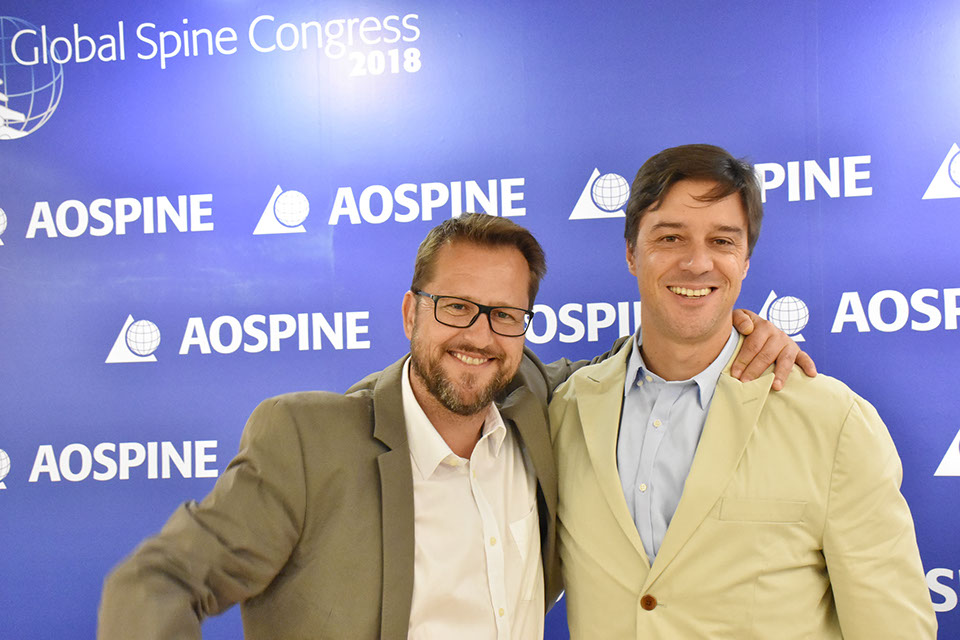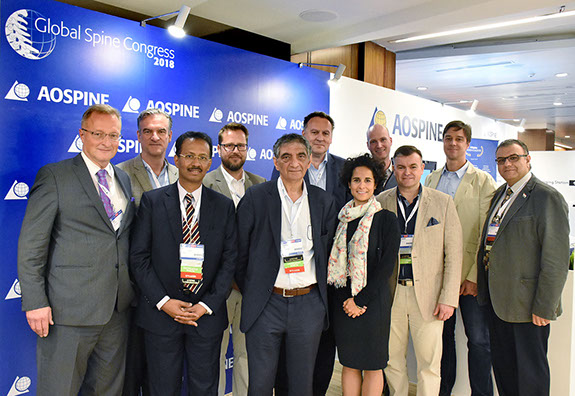feature storIES
HIGHLIGHTS
AOSpine Invites Young Researchers to Get Involved
AOSpine DegenPRO Registry—A Goldmine of Data
Meet AOspine Members

How to Get Involved in AOSpine Research—and why we think you should do it
AOSpine Research regularly announces calls for proposals and for participation in new studies performed by the AOSpine Knowledge Forums (KF), our five expert-driven research working groups. Open calls are sent to AOSpine members who have opted into receiving our emails. Here, three AOSpine members share their experiences on how they got involved, give tips to steer your career towards research, and insights to why it’s worth it.
AOSpine Research Commission Chairman Dino Samartzis confirms the interest in research is growing amongst spine surgeons and clinicians globally. “More and more members want to participate in our studies or become “It’s challenging, which makes it fun. It makes you part of a bigger thing.”members in the AOSpine Knowledge Forums. This is great news for science and for the future of patient care.”
Working besides world-renowned spine researchers is inspiring and rewarding. AOSpine researchers can contribute to progressing the field of managing spine trauma and disorders, and they learn more from their clinical cases. “It’s challenging, which makes it fun,” Global Research Manager Niccole Germscheid thinks. “Rubbing shoulders with the research giants and disseminating research findings in symposia and conferences; it makes you part of a bigger thing.”
In time, giving back and mentoring others will be another reward. “But making it to the top is hard work and takes time, similarly, to conducting meaningful research.” Samartzis warns.
Pathways to a career in research
Networking is important, just as it is in any business, and the Global Spine Congress and Davos Courses provide opportunities to meet with global spine researchers and influencers.
Lorin Benneker remembers working with Mauro Alini and Keita Ito as a fellow in the AO Research Institute (ARI) and learning about experimental research from basic scientists. Later, working as faculty at the AO Davos courses he ran into the current AOSpine KF Trauma Chairperson Cumhur Öner and started talking about cases. Benneker went on to do a fellowship with Öner, started contributing patients in AOSpine KF Trauma studies, and eventually earned a member position in the KF.
“You have to gain experience and merit from translational or clinical studies first, which is hard labor in addition to your daily work with patients. But there is no way around it,” Benneker states.
Emiliano Vialle from Brazil echoes the thoughts and sees no short cuts in how to get involved. “Not even being my Father’s son,” Vialle laughs. “I’ve been involved in helping my mentors with their research projects since my “Research is a continuous cycle; you learn from your mistakes and build on previous achievements.”residency. It’s an ongoing process: first you contribute cases to the studies, then you may be invited as an associate member, and you keep on giving support.”
Before being invited to the KF, both Vialle and Benneker represented their Regions as Research Officers, which provides another pathway to get involved. The AOSpine Regional Research Officer positions are open every 3 years; elections for Europe and Asia Pacific are taking place in April 2019.

 1 - 2<>
1 - 2<>
Working in the National Trauma Center in Kathmandu, Dhakal primarily deals with spine trauma.
Gaurav Dhakal is the newest AOSpine KF Trauma associate member. His association with AOSpine dates back a decade to the first AOSpine symposium held in Nepal. During his spine fellowship with Saumyajit Basu in India, Dhakal was introduced to AOSpine research with irreversible consequences. “It instilled in me the desire to indulge in more research work and to pursue projects that I could do home in Nepal.”
To follow his research desire, Dhakal successfully applied to the AOSpine Research mentorship program. Supervised by Dan Riew and Yoshiharu Kawaguchi he co-authored manuscripts in academic journals, including the AOSpine’s own Global Spine Journal.
“At the Davos Courses and the Global Spine Congress 2018, I then got talking with AOSpine KF Trauma members. With their encouragement and as a result of my growing track record and research interests, I applied and was accepted as an associate member last October,” Dhakal explains.

The AOSpine KF Trauma Steering Committee and Associate Members at the GSC 2018, Singapore. From left to right: Jens Chapman, Marcel Dvorak, S. Rajasekaran, Lorin Benneker, Cumhur Öner (chairperson), Frank Kandziora, María Alvarez Sánchez (KF Manager), Greg Schröder, Klaus Schnake, Elimiano Vialle, and Mohammad El-Sharkawi.
There are no short cuts
Before you will be invited to participate in AOSpine studies, you must know how to do high quality research and, above all, demonstrate you are committed and able to perform. “In Americas, we have a whole curriculum on how to do research, but if you don’t have the research infrastructure, it’s going to be very difficult to participate in big studies like the ones done by the KFs,” Vialle stresses.
“There are many open calls for studies,” Vialle continues. “Often people are eager to participate, they have the cases, but lack the administrative capability “It was time to learn of the ongoing activities of AOSpine Research and start contributing.”to run the studies. The bureaucracy of research is an important part of studies not to waste time and money.”
When all the above falls into place, your AOSpine membership can bring you far in research. “Participating in the AOSpine Knowledge Forums is a beautiful reward, if you like, to your commitment with the AO Foundation. It’s the most valuable participation in the AO for me,” Vialle says. To Benneker, AOSpine’s KFs are the “crown of the AO” and he understands the eagerness to be associated with them. “It’s the part of AO where you can achieve a lot. I did not have to think twice when the opportunity arose.”
“I believe that wherever we may be working, in whatever environment, we all have something to contribute to the spine fraternity. AOSpine is the best forum for it,” Dhakal concludes. “I strongly recommend spine surgeons from all regions become a part of this endeavor.”
AOPEER is a great tool to get you started. The online tool offers training in all phases of clinical research and is free to all AO members. The AOSpine regions offer also AOPEER courses. AOPEER is supported by AO Clinical Investigation and Documentation (AOCID) and the AO Education Institute (AOEI). More information and a list of upcoming courses is available at www.aopeer.org ![]() .
.
AOSPINE KNOWLEDGE FORUMS TEASER SESSION at the Global Spine Congress in Toronto, Canada, on 16 May 2019 is your opportunity to get to know the KFs. For the GSC2019 program and networking opportunities go to
To learn more about the AOSpine Knowledge Forums and our ONGOING STUDIES visit www.aospine.org/kf ![]() .
.
For OPEN CALLS, FUNDING, AND OTHER RESEARCH OPPORTUNITIES, visit our website or follow us on Twitter and Facebook.
Newsletter 20 | March 2019
Newsletter 20
March 2019
Meet AOspine Members